 W
WThe Battle of Abu Klea, or the Battle of Abu Tulayh took place between the dates of 16 and 18 January 1885, at Abu Klea, Sudan, between the British Desert Column and Mahdist forces encamped near Abu Klea. The Desert Column, a force of approximately 1,400 soldiers, started from Korti, Sudan on 30 December 1884; the Desert Column's mission, in a joint effort titled "The Gordon Relief Expedition", was to march across the Bayuda Desert to the aid of General Charles George Gordon at Khartoum, Sudan, who was besieged there by Mahdist forces.
 W
WThe Battle of Bang Bo, known in China as the battle of Zhennan Pass, was a major Chinese victory during the Sino-French War. The battle, fought on 23 and 24 March 1885 on the Tonkin-Guangxi border, saw the defeat of 1,500 soldiers of General François de Négrier's 2nd Brigade of the Tonkin Expeditionary Corps by a Chinese army under the command of the Guangxi military commissioner Pan Dingxin (潘鼎新).
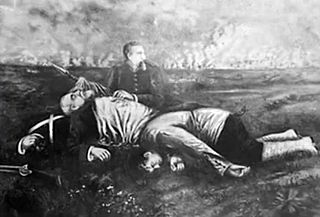 W
WBarrios' War of Reunification was a war initiated by President Justo Rufino Barrios of Guatemala. His goal was to reunify Central America with himself as President. He died in battle on 2 April 1885 and peace was reached on 14 April.
 W
WThe Cần Vương movement was a large-scale Vietnamese insurgency between 1885 and 1889 against French colonial rule. Its objective was to expel the French and install the boy emperor Hàm Nghi as the leader of an independent Vietnam. The movement lacked a coherent national structure and consisted mainly of regional leaders who attacked French troops in their own provinces. The movement initially prospered as there were only a few French garrisons in Annam, but failed after the French recovered from the surprise of the insurgency and poured troops into Annam from bases in Tonkin and Cochinchina. The insurrection in Annam spread and flourished in 1886, reached its climax the following year and gradually faded out by 1889.
 W
WThe Battle of Chalchuapa was a battle fought between the military forces of El Salvador and Guatemala from 1–2 April 1885. Guatemalan President Justo Rufino Barrios was killed in action during the battle.
 W
WThe Battle of Cut Knife, fought on May 2, 1885, occurred when a flying column of mounted police, militia, and Canadian army regular army units attacked a Cree and Assiniboine teepee settlement near Battleford, Saskatchewan. First Nations fighters forced the Canadian forces to retreat, with losses on both sides.
 W
WThe Battle of Đồng Đăng was an important French victory during the Sino-French War. It is named after the town of Đồng Đăng, then in northern Tonkin, close to the border between China and Vietnam.
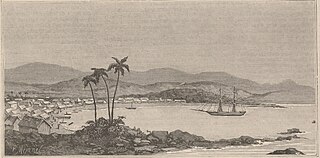 W
WThe First Madagascar expedition was the beginning of the Franco-Hova War and consisted of a French military expedition against the Merina Kingdom on the island of Madagascar in 1883. It was followed by the Second Madagascar expedition in 1895.
 W
WThe Battle of Ginnis was a minor battle of the Mahdist War that was fought on December 30, 1885, between soldiers of the Anglo-Egyptian Army and Mahdist Sudanese warriors of the Dervish State. The battle was caused by the Mahdist blockade of the Ginnis-Kosha Fort, which British commanders hoped to relieve.
 W
WThe Battle of Hòa Mộc was the most fiercely fought action of the Sino-French War. At heavy cost, Colonel Giovanninelli's 1st Brigade of the Tonkin Expeditionary Corps defeated forces of the Black Flag and Yunnan Armies blocking the way to the besieged French post of Tuyên Quang.
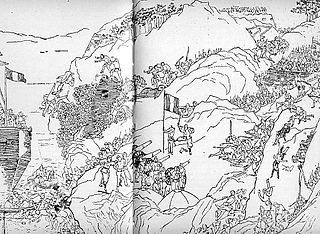 W
WThe Keelung campaign was a controversial military campaign undertaken by the French in northern Formosa (Taiwan) during the Sino-French War. After making a botched attack on Keelung in August 1884, the French landed an expeditionary corps of 2,000 men and captured the port in October 1884. Unable to advance beyond their bridgehead, they were invested inside Keelung by superior Chinese forces under the command of the imperial commissioner Liu Mingchuan. In November and December 1884 cholera and typhoid drained the strength of the French expeditionary corps, while reinforcements for the Chinese army flowed into Formosa via the Pescadores Islands, raising its strength to 35,000 men by the end of the war. Reinforced in January 1885 to a strength of 4,500 men, the French won two impressive tactical victories against the besieging Chinese in late January and early March 1885, but were not strong enough to exploit these victories. The Keelung campaign ended in April 1885 in a strategic and tactical stalemate. The campaign was criticised at the time by Admiral Amédée Courbet, the commander of the French Far East Squadron, as strategically irrelevant and a wasteful diversion of the French navy.
 W
WThe Battle of Kirbekan was a battle in the Mahdist War. It was fought February 10, 1885, when the British Nile Column, about 1,000 strong, under General Earle, stormed the heights of Kirbekan, which were held by a strong Mahdist force, and totally routed them, with heavy loss.
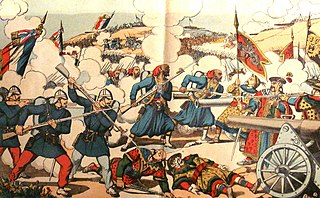 W
WThe Lạng Sơn campaign was a major French offensive in Tonkin during the Sino-French War. The Tonkin Expeditionary Corps, under the command of General Louis Brière de l'Isle, defeated the Chinese Guangxi Army and captured the strategically important town of Lạng Sơn in a ten-day campaign mounted under formidable logistical constraints.
 W
WThe Battle of Little Dry Creek was a skirmish during Geronimo's War. Chiricahua Apache warriors were raiding in the Arizona and New Mexico border area when they ambushed a larger force of United States Army troops and Navajo Scouts near Pleasanton.
 W
WThe Battle of Loon Lake concluded the North-West Rebellion on June 3, 1885 and was the last battle fought on Canadian soil. It was fought in what was then the District of Saskatchewan of the Northwest Territories, at what is now known as Steele Narrows, in Saskatchewan's Makwa Lake Provincial Park.
 W
WThe Mandor rebellion in 1884 and 1885, also called the Third Kongsi War, was an uprising of ethnic Chinese, helped by the Dayaks, against the Dutch East Indies government.
 W
WThe Nauruan Civil War was fought from 1878 to 1888, between forces loyal to incumbent King Aweida of Nauru and those seeking to depose him in favour of a rival claimant. The war was preceded by the introduction of firearms to Nauru. For the majority of the war, the loyalists and the rebels found themselves in a stalemate, with one side controlling the north and the other controlling the south. In 1888, The German Empire intervened and restored Aweida to the throne, although the island was annexed in the process. By the end of the war, about 500 people had died, around a third of the population.
 W
WThe Nile Expedition, sometimes called the Gordon Relief Expedition (1884–85), was a British mission to relieve Major-General Charles George Gordon at Khartoum, Sudan. Gordon had been sent to the Sudan to help Egyptians evacuate from Sudan after Britain decided to abandon the country in the face of a rebellion led by self-proclaimed Mahdi, Mahommed Ahmed. A contingent of Canadians was recruited to help the British navigate their small boats up the Nile River. The Nile Expedition was the first overseas expedition by Canadians in a British imperial conflict, although the Nile Voyageurs were civilian employees and did not wear uniforms.
 W
WThe Battle of Nui Bop was a French victory during the Sino-French War. The battle was fought to clear Chinese forces away from the French forward base at Chu, and was an essential preliminary to the Lạng Sơn Campaign in February 1885.
 W
WThe Panjdeh incident was an armed engagement between Afghanistan and the Russian Empire in 1885 that led to a diplomatic crisis between the British Empire and the Russian Empire caused by the Russian expansion south-eastwards towards the Emirate of Afghanistan and the British Raj (India). After nearly completing the Russian conquest of Central Asia the Russians captured an Afghan border fort. Seeing a threat to India, Britain came close to threatening war but both sides backed down and the matter was settled by diplomacy. The effect was to stop further Russian expansion in Asia, except for the Pamir Mountains and to define the north-western border of Afghanistan.
 W
WThe Peruvian civil war of 1884–1885 was an internal Peruvian conflict that resulted from Peru's defeat in the War of the Pacific. The casus belli was the Treaty of Ancon.
 W
WThe Pescadores campaign which took place in late March, 1885, was one of the last campaigns of the Sino-French War. It was fought to capture a strategically important island group off the western coast of Formosa (Taiwan). Admiral Amédée Courbet, with part of the French Far East Squadron, bombarded the Chinese coastal defences around the principal town of Makung (馬公) on Penghu Island (澎湖島) and landed a battalion of marine infantry which routed the Chinese defenders and occupied Makung.
 W
WThe Battle of Phu Lam Tao was a politically significant engagement during the Sino-French War, in which a French Zouave battalion was defeated by a mixed force of Chinese soldiers and Black Flags.
 W
WThe Battle of Pirot took place during the Serbo-Bulgarian War between the 26th and 27 November, 1885 near the town of Pirot, Serbia.The battle opposed the Bulgarian Western Corps to the Serbian Nišava Army and ended with a Bulgarian victory and the signing of an armistice. The battle led to the treaty of Bucharest ending the Serbo-Bulgarian War restoring peace between the two countries.
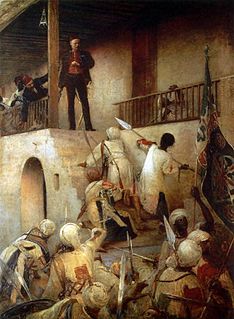 W
WThe Battle of Khartoum, Siege of Khartoum or Fall of Khartoum was the conquest of Egyptian-held Khartoum by the Mahdist forces led by Muhammad Ahmad. Egypt had held the city for some time, but the siege the Mahdists engineered and carried out from 13 March 1884 to 26 January 1885 was enough to wrest control away from the Egyptian administration. After a ten-month siege, when the Mahdists finally broke into the city, the entire garrison of Egyptian soldiers was killed along with 4,000 Sudanese civilians.
 W
WThe Siege of Tuyen Quang was an important confrontation between the French and the Chinese armies in Tonkin during the Sino-French War. A French garrison of 630 men, including two companies of the French Foreign Legion, successfully defended the French post of Tuyen Quang against vastly outnumbering Chinese forces in a four-month siege from 24 November 1884 to 3 March 1885. 'Tuyen Quang 1885' remains one of the Legion's proudest battle honours.
 W
WThe Sino-French War, also known as the Tonkin War and Tonquin War, was a limited conflict fought from August 1884 through April 1885. There was no declaration of war. Militarily it was a stalemate. The Chinese armies performed better than in other nineteenth-century wars and the war ended with French retreat on land. However, one consequence was that France supplanted China's control of Tonkin. The war strengthened the dominance of Empress Dowager Cixi over the Chinese government, but brought down the government of Prime Minister Jules Ferry in Paris. Both sides were satisfied with the Treaty of Tientsin. According to Lloyd Eastman, "neither nation reaped diplomatic gains."
 W
WThe Battle of Slivnitsa was a decisive victory of the Bulgarian army over the Serbians on November 17–19, 1885 in the Serbo-Bulgarian War. It solidified the unification between the Kingdom of Bulgaria and Eastern Rumelia.
 W
WThe Third Anglo-Burmese War, also known as the Third Burma War, was a conflict that took place during 7–29 November 1885, with sporadic resistance and insurgency continuing into 1887. It was the final of three wars fought in the 19th century between the Burmese and the British. The war saw the loss of sovereignty of an independent Burma under the Konbaung dynasty, whose rule had already been reduced to the territory known as Upper Burma, the region of Lower Burma having been annexed by the British in 1853, as a result of the Second Anglo-Burmese War.
 W
WThe Battle of Tofrek was fought on 22 March 1885 some 5 miles inland from the port of Suakin on the Red Sea coast of Sudan. A contingent of some 3000 troops from the British and Indian "Suakin Field Force" led by Major General Sir John Carstairs McNeill VC, GCVO, KCB, KCMG was attacked by a Mahdist force under the leadership of Osman Digna. The Mahdists were heavily defeated, losing some 1000 of their 2000 fighters as compared to the loss of 70 British and Indian soldiers plus over 100 casualties.
 W
WThe Tonkin Affair, named after the French protectorate of Tonkin, of March 1885 was a major French political crisis that erupted in the closing weeks of the Sino-French War. It effectively destroyed the political career of the French prime minister, Jules Ferry, and abruptly ended the string of Republican governments inaugurated several years earlier by Léon Gambetta. The suspicion by the French public and political classes that French troops were being sent to their deaths far from home for little measurable gain, both in Tonkin and elsewhere, also discredited French colonial expansion for nearly a decade.
 W
WThe Tonkin campaign was an armed conflict fought between June 1883 and April 1886 by the French against, variously, the Vietnamese, Liu Yongfu's Black Flag Army and the Chinese Guangxi and Yunnan armies to occupy Tonkin and entrench a French protectorate there. The campaign, complicated in August 1884 by the outbreak of the Sino-French War and in July 1885 by the Cần Vương nationalist uprising in Annam, which required the diversion of large numbers of French troops, was conducted by the Tonkin Expeditionary Corps, supported by the gunboats of the Tonkin Flotilla. The campaign officially ended in April 1886, when the expeditionary corps was reduced in size to a division of occupation, but Tonkin was not effectively pacified until 1896.
 W
WThe Treaty of Tientsin, signed on June 9th, 1885, officially ended the Sino-French War. The unequal treaty restated in greater detail the main provisions of the Tientsin Accord, signed between France and China on May 11th, 1884. As Article 2 required China to recognize the French protectorate over Annam and Tonkin established by the Treaty of Hue in June 1884, which implicitly forced China to abandon its claims to suzerainty over Vietnam, the treaty formalized France's diplomatic victory in the Sino-French War.
 W
WThe Battle of Zhenhai was a minor confrontation that took place on 1 March 1885 between Admiral Amédée Courbet's Far East Squadron and Chinese warships and shore batteries near the coastal city of Zhenhai, 12 miles (19 km) downstream from Ningbo, China during the Sino-French War. French and Chinese sources disagree sharply as to what happened; French sources treat the encounter as a minor incident, while Chinese sources consider it a striking defensive victory. The Battle of Zhenhai is still commemorated in China as an important Chinese victory in the Sino-French War.